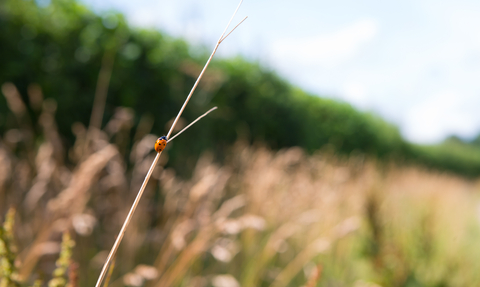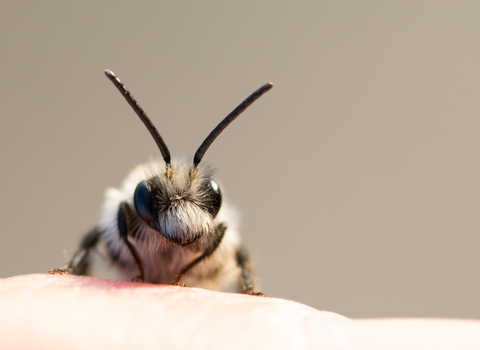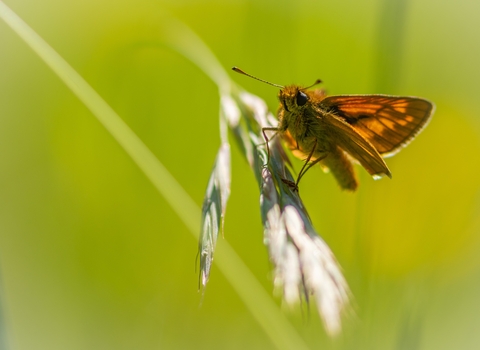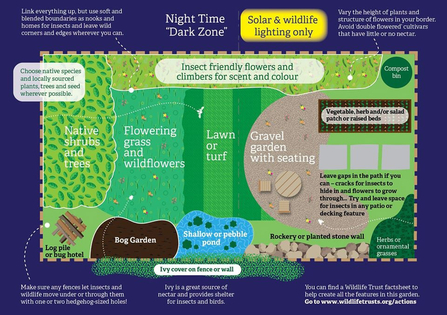
Hedgerows (c) Jon Hawkins, Surrey Hills Photography
Don't mow, let it grow
You might have heard of No Mow May, but did you know you can help the wildlife in your garden by letting it go wild throughout spring and summer?
Combined, our gardens make up an area bigger than all of the UK's nature reserves put together, making them a vital source of food and shelter for pollinators and other insects. Plantlife's ask is a simple one - do nothing!
Lock the mower away and let the wildflowers in your lawn bloom, providing a feast of nectar for our hungry pollinators. You'll be providing food for not only bees, but the beetles, wasps and flies that are important for pollinating flowers and crops, and are a crucial part of the food chain.
Each year, those that embrace a wilder lawn have seen some exciting flowers popping up. In 2021, Plantlife received records of bee orchids, snake’s-head fritillaries and eyebrights. What will you see this year?
If you haven’t already, you can also pledge your patch to the People’s Nature Reserve and become part of a community of nature lovers taking action for wildlife.
When can I start?
The best time to let it grow is between April and September.
If you've missed No Mow May, you can Let It Bloom in June, or take part in Knee-high July!
Waiting until all of the flowers have gone over before cutting will have the biggest impact.
How much lawn should I let grow?
You don't have to let the whole of your garden grow wild - leaving just a few patches around the edges can benefit a whole host of insects, giving them a place to hide, breed and even lay eggs, supporting the next generation.
What should I do when I'm ready to cut the grass?
Although you can cut the grass at any time, though the longer you leave it, the better the result for wildlife!
When you're ready to get the mower back out, follow these simple steps to make the most of the cuttings:
- Once you've mown or strimmed the grass, leave the cuttings to dry where they are for a few days.
- Shake the seeds out - you can share these with others to kickstart their own mini meadow, or sow them in your own patch.
Then you have a few options:
- Have a go at composting - you can find a beginners guide here.
- Take some woody cuttings from shrubs to combine with the grass, and finding a nice quiet spot you can make a natural insect habitat
If you don't want to cut all the grass in one go, try doing it in sections. This still gives the insects somewhere to go as you start winding down to autumn.
How many flowers does it take?
Every flower counts! Five daisies, two dandelions and six buttercups together provide enough nectar to support a honeybee a day.
On a single day in summer, one acre of wildflower meadow can contain three million flowers, producing one kilogram of nectar sugar. That’s enough to support nearly 96,000 bees per day.
If you'd like to let your neighbours and passers by know what's going on, you can download our free signs to inspire others (details below).

Ashy mining bee (c) Paul Sergeant, submitted to GWT's 2018 photo competition
Get a free guide on bringing your lawn to life!
With a bit of care and attention – or even inattention – a lawn can provide a sanctuary for our natural neighbours.
If you want to transform your turf to embrace wildlife, this booklet is the perfect place to start. It contains all the information you need, as well as wildlife spotting sheets and fun activities
Want to take it a step further?
There are some fantastic ways to make this challenge a more active one:
Get rewarded for your green actions
Get rewarded for activities like growing a wild lawn by signing up and join the WilderGlos community, where you can earn points, climb the leaderboard, and earn prizes.
WilderGlos is an online platform available to anyone living in Gloucestershire where you can take part in activities to boost biodiversity.
Get spotting
By letting parts of your garden grow wild, we're sure you'll see lots of new plants, insects, and even birds in your now wild space. This is a great opportunity to download some spotter sheets or use our wildlife explorer pages to narrow down what it is you've seen.
Your sightings help to build valuable records of our county that we use to monitor species increases, declines, and movements, and they even help us advise on planning applications.
We'd love to know what wildlife you've seen as a result of taking part in the challenge, once you’ve built your habitat house or even just while you're out and about. Report your sighting to our records centre, GCER, to let us know what you’ve seen - no matter how common you think it is!
The gardens of Gloucestershire
We love seeing pictures of how you're letting parts of your garden grow a little wilder. If you'd like to see yours featured, please send your pictures to marketing@gloucestershirewildlifetrust.co.uk.

Little skipper (c) Mark Cox
Are you a council or a farmer?
If you’re a council, join in by leaving parks and road verges to go wild. Plantlife's Road Verge Campaign provides award-winning guidance on how to mow less often and later in the year instead.
If you're a farmer, letting the field margins or corners grow wild can have a huge impact for insects. The benefits will also spill over into your crops as well, with pollinators buzzing between them fertilising the flowers. If you have more space to give, a three acre meadow can be home to nine million flowers producing enough nectar to support half a million bees every day!
If you wish to learn more about the ELM scheme, please contact Tim Bevan, GWT's Lead Farm Advisor at tim.bevan@gloucestershirewildlifetrust.co.uk
Interested in making your garden as wildlife friendly as possible? Check out the garden plan below to see what how we recommend structuring the space, or check out this free Wild About Gardens booklet and our wildlife gardening pages.

A guide to how to structure a wildlife garden









